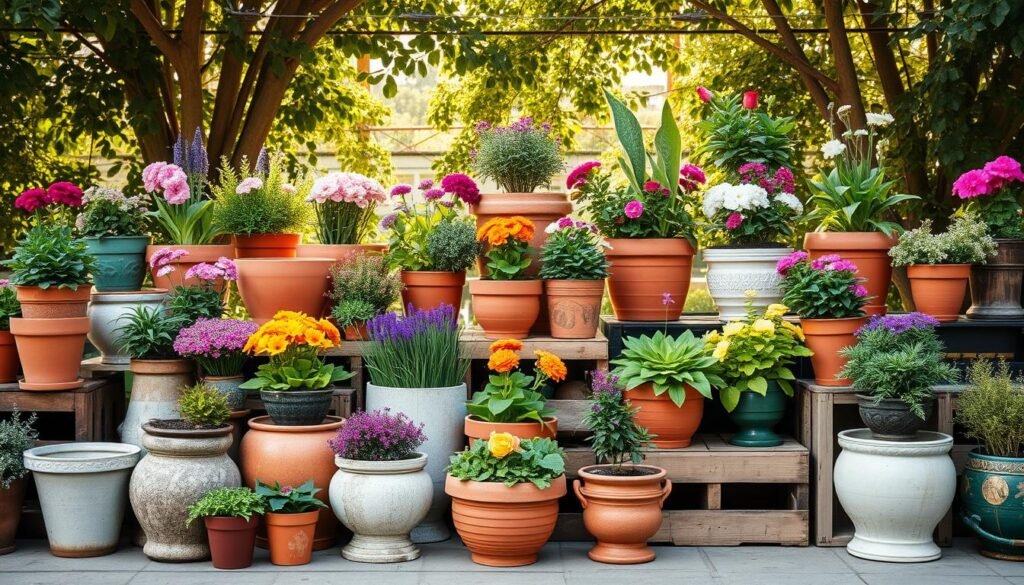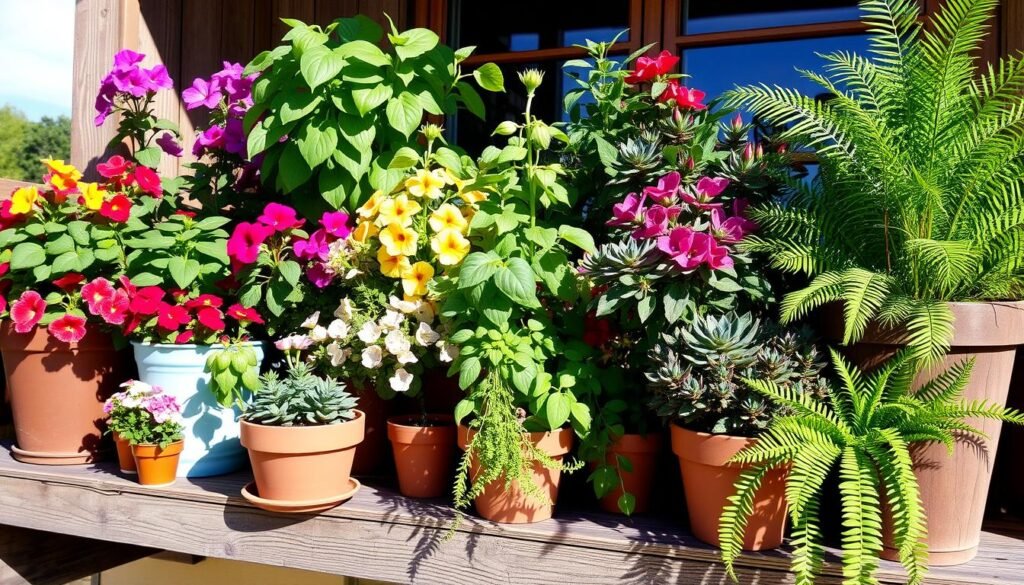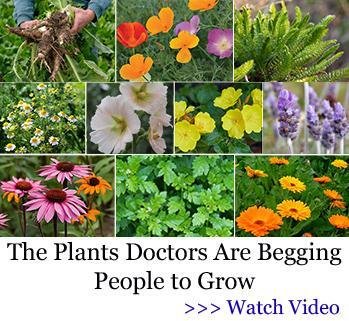Starting a container garden is a great adventure, especially in the city where space is tight. You can start this journey even with just a bit of room on a balcony or a sunny spot near a window. Knowing the right pots, soil, and plants will help you grow successfully.
Container gardening stands out because you can move the pots around. You can grow lots of plants, like tasty herbs or fresh greens. When beginning a container garden, picking a top-notch potting mix is crucial. This prevents the soil from getting too hard and keeps water flowing right.
We talked to experts who have 75 years of combined gardening know-how. They shared key advice to get you started with container gardening easily. It’s a hobby that’s both easy to start and very rewarding, perfect for adding green to your living space.
Why Choose Container Gardening?
Container gardening is a top choice for those with little space or poor soil. This space-saving gardening method lets you grow plants in small areas like balconies. The beauty of container gardening is its flexibility to grow a variety of plants anywhere.

Advantages of potted plants include better control over the growing conditions. You can grow almost anything, from tomatoes in big pots to lettuce and flowers in smaller ones. This control is great for urban container gardening, where you’re working with limited space.
Container gardening also lets you move plants for more sunlight or to protect them from harsh weather. It’s easier to manage, perfect for beginners or those who like trying new things. Containers also help with soil quality and pest control, which is beneficial even in rural areas.
Yet, container gardens need regular watering, especially in summer’s heat. Using items like Pitt Moss can cut down water use. Self-watering containers and drip systems make watering easier, keeping plants healthy.
Containers also bring the benefit of moving plants easily and avoiding soil-borne diseases. You can fine-tune the soil for your plants. Using organic fertilizers like Drammatic helps your plants without hurting the environment.
But space-saving gardening isn’t just practical; it’s also about adding beauty all year round. Plants like marigolds, zinnias, and petunias thrive in containers. They bring color and attract pollinators, turning your space into a vibrant green haven.
Essential Tools for Container Gardening
Starting your journey in container gardening means gathering the right tools. It’s important whether you’re planting in terracotta, plastic, or fabric pots. The proper tools can greatly affect your gardening success.
At the top of the list is a high-quality garden trowel. It’s crucial for filling pots, planting, and removing soil. A soil scoop helps fill containers neatly, avoiding spills. Also, a garden fork is great for untangling roots, helping them grow well in their new pot.
A Hori Hori knife from Japan is a must-have. It’s perfect for making holes and cutting overgrown roots. To keep plants healthy, you need pruners and snips for trimming and deadheading.
Don’t forget pot feet or risers to improve drainage and stop rot. While working, sturdy garden gloves are important for protection and easy clean-ups.
Containers, whether terracotta, plastic, or fabric, can dry out fast. That’s why a good watering can or hose is key to keeping plants hydrated. Plant markers are also helpful to remember what you planted and their care. A balanced fertilizer is vital for your garden’s success.
Consider sun protection like shade cloth or plant covers for days that are too sunny. For larger gardens, or moving heavy things, a wheelbarrow or garden cart is very helpful.
With the right container gardening tools and good practices, you’re all set. You can have a great garden, no matter your space or budget.
Choosing the Right Containers
Choosing the right containers for your garden is key to success. When picking planter selection, consider materials, durability, cost, and how they look. Different options have their own pros and cons.
Terra cotta pots are loved for their breathability which helps plant roots. But, they need more watering because they dry fast. These pots can also break in cold weather. Plastic containers, on the other hand, are light, cheap, and come in lots of styles. They’re easy to move but might get too hot, which is bad for the plants.

Wooden planters, like half barrels, look natural and last for years. But, they get heavy as they soak up water. They protect plant roots well but might need treating to stop rot. Concrete pots are very durable but also very heavy. They’re great for staying in one spot but are pricey and hard to move.
The size of the pot is really important for plant health. A big, 24-inch pot is good for large plants like pepper and tomatoes. A smaller, 14-inch pot is great for herbs and veggies like cabbage. Big pots don’t need water and food as often as small pots.
Thinking about the environment? Try using old buckets, tires, and crates for an eco-friendly garden. Just make sure they have holes for drainage to avoid waterlogged roots.
Remember, the color of your container matters too. White or light shades reflect light, keeping roots cool. Dark colors soak up heat, which changes soil temperature. Choosing the right container helps your plants grow well, making your garden beautiful and productive.
Selecting the Best Soil and Fertilizers
When you start container gardening, choosing the right soil is crucial. High-quality organic potting soil is a must. It provides nutrients and better aeration than regular garden soil. Regular soil compacts easily and does not hold water well. On the other hand, organic, compost-based mixes are better. They keep the right balance of nutrition, moisture, and air for plants.

Don’t go for cheap soil. It often has too much sand and lacks nutrients. Instead, use trusted brands like Garden Soil Plus from The Dirt Bag. They offer top-notch soil for container gardens. Plus, unopened soil bags stay good for up to six months. So, you can buy ahead of time.
Don’t forget about fertilization. Start with an all-purpose fertilizer a few weeks after planting. Choose fertilizers with more phosphorus or potassium and less nitrogen. This helps boost flower and fruit growth. Organic fertilizers are great too. They release nutrients slowly, feeding your plants all season.
“Use dolomite every growing season to improve the concentration and availability of essential elements for plants,” recommends EarthBox. This practice allows the reuse of potting mix for many years and can double yields compared to traditional garden beds.
Soil depth matters a lot as well. Small plants do well with 6-8 inches of soil. Medium ones need 10-12 inches. And large plants, like tomatoes, require at least 18 inches. EarthBox offers containers in various depths. They have options from 7 inches for herbs to more than 15 inches for root veggies.
Keeping the soil moist is key. In hot weather, you might need to water daily. But be careful not to overdo it. Too much water can make the soil soggy. This leads to nitrogen loss and stresses the plants.
How to Pick the Right Plants for Your Container Garden
Starting a container garden means picking the suitable plants for pots carefully. This ensures your garden grows well. Knowing how much sunlight your space gets is key. Full sun plants need six hours of sunlight a day. Part shade plants do best with 4-6 hours. Meanwhile, full shade plants need less than four hours to thrive.
Choosing the right veggies is a smart move. For container gardening, plants like lettuce, tomatoes, strawberries, and dwarf citrus trees are top picks. They use limited space wisely and produce a good yield. For those who love cooking, adding herb planting such as basil and mint makes your garden a source of fresh flavors.
Don’t forget about ornamental blooms to make your garden look beautiful. Flowers like impatiens, petunias, and marigolds bring color and texture. Mixing dwarf varieties with others helps create a balanced look. This allows plants to support each other’s growth needs.

The size of your pots matters a lot. A 10-12” pot fits three small plants perfectly. If you’re using bigger pots, putting in seven or more plants will look great right away. But, fewer plants will grow to fill the space over time. Remember, bigger pots made of plastic or glazed ceramic help plants grow by keeping more moisture and nutrients.
Grouping plants at the store helps you visualize how many will fit in your picked container, ensuring you achieve a lush and balanced garden design.
Think about mixing different types of plants. Putting edibles like herbs and greens together with ornamental plants makes your garden both pretty and useful. Common flower choices are petunias, marigolds, and begonias. These go well with edible herbs and showy grasses like fountain grass, adding dramatic looks.
When you choose the suitable plants for pots correctly, you can make any space a green haven. This is true whether you live in a small apartment or have a large yard. Try different plants and pots to see what looks good and grows well in your garden.
Planting Techniques for Container Gardens
Starting a container garden is easy with the right plants, pots, and soil. Knowing how to plant correctly is key for healthy plants and bright flowers. It makes sure your garden grows well.
First, fill your pots two-thirds with high-quality potting mix. Don’t use garden soil; it’s too heavy and drains poorly. For pot sizes and plant amounts, follow this rule: a 10″ to 12″ pot can fit 3-4 plants, a 14″ to 16″ pot holds 5-7, and a 16″ to 20″ pot fits 6-9. This keeps plants from getting too crowded.

Think about the ‘thriller, filler, spiller’ design for your plants. Thrillers go in the center and stand tall. Fillers make the pot look full, and spillers hang over the sides, making everything flow together.
Putting in plants from nurseries? Check they’re healthy first. Loosen the roots gently, then plant them as they need to grow. Water your planter until water flows out the bottom. Check the soil each day to keep plants happy.
When picking plants, think about colors, textures, and what light they need. You can mix annuals, perennials, veggies, and shrubs for a pretty and useful garden. Experts say you can grow anything in a pot.
Use these tips, and your container garden will thrive. You’ll love the beauty and joy it adds to your space.
Watering Your Container Garden
To water your container garden well, you should follow certain garden watering guidelines. Start by checking if the soil is dry one inch down. Since container plants have less soil and are exposed more, they dry out quickly.
It’s very important to water the soil, not the leaves. This stops illness and makes sure the roots get the water. Morning is the best time to water. This way, the water doesn’t evaporate in the heat of the day but is used by the plant.
Morning is the best time to water plants in containers to maximize moisture absorption before evaporation occurs.
Good drainage is key to avoid root rot. Make sure containers have holes to let out extra water. Always check deeper in the soil to really know when to water your plants.
In warm weather, plants may need water more often. Stuff like terracotta pots dry out faster than plastic or ceramic ones. It’s common for new gardeners to not water enough, so keep a close eye on your plants.
Watering deeply is best for strong roots. This also means you won’t have to water as much later on. But don’t overwater—too much is just as bad as not enough. By sticking to these garden watering guidelines, your container garden will stay healthy and bright.
Maintenance and Care for Vibrant Growth
To help your container garden grow well, you need a good care routine. Start deadheading plants often. This gets rid of old flowers and helps new ones grow. Pruning is also key to keep plants healthy and looking good. Plus, dealing with bugs early is crucial to stop them from harming your plants.
Fertilizing right can really bring out your garden’s colors. Use slow-release fertilizers to feed plants over time. Be careful with watering; too much or not enough can hurt your garden. Make sure to water until it drains out, so all the soil gets moist.
Being active in your garden’s care is important. Move plants to get the right amount of light and change the soil when needed. Group plants by their water and light needs for best growth. Watch indicator plants to know when to water. A regular care routine not only keeps your garden looking beautiful but also makes gardening more fun and rewarding for you.









